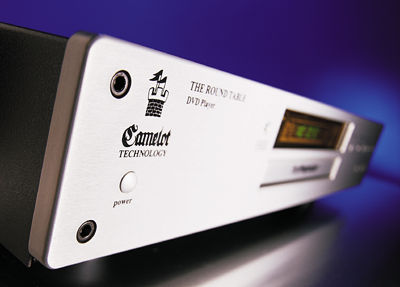Camelot Technology Round Table DVD player

This is quite opposite to what you find in products from small specialty companies like Camelot, which tend to concentrate more on building high-performance gizmos they'd like to own themselves than on defining market niches and then devising products to fill them. Not that the smaller, high-end companies are averse to taking advantage of the considerable R&D might of the conglomerates. Like other small, innovative companies, Camelot doesn't build its own DVD players from the ground up. Instead, it buys off-the-shelf models that it then guts and/or heavily modifies to offer features, levels of performance, and prices the original designers never dreamed of.
Camelot's Round Table begins life as a $300 Panasonic A-110 DVD player. By the time Camelot has finished its makeover, the price has exploded to $3995—quite a leap. But in the case of the Round Table, it's quite a makeover. Camelot has put the A-110 in a heavier, higher-quality chassis and dressed it up to look and feel like the premium-priced product it now is, with a neat black-matte faceplate and round silver buttons. But there's a lot more than that to the upgrade—we're not just talking about $3695 worth of cosmetics.
When you turn it on, Panasonic's familiar bouncing blue logo appears on the screen—not a big problem. A bigger problem is Panasonic's crowded little unlit remote and the player's less-than-premium fast-forward and scan modes. They're okay, but not state-of-the-art. Still, for users who just want to sit down and watch a movie, the A-110's effects performance, and even its remote, should prove (barely) adequate.
The Panasonic A-110 is a basic DVD player, but by all accounts it features an extremely well-designed and accurate MPEG-2 decoder board—one of the reasons the extremely talented designer Doug Goldberg (whose day job is as an engineer at Northrup) chose it as the foundation of the Round Table. As a former pleased owner of an A-110, I wasn't surprised that the RT shared one of the A-110's few negative qualities: it didn't do well with scratched or dirty discs. Rental DVDs that my Pioneer DV-05 accepted happily gave the Round Table heartburn. The condition is not fatal—a cleaning with a good CD or DVD cleaner/polisher improved the RT's appetite, and every rejected disc eventually played. Also, while the DV-05 will play CD-Rs, the Round Table will not.
But that's the end of my complaints about the Round Table, which offers an incredible array of useful and, in some cases, crucial features, as well as superb audio and video performance. First, the RT uses the highly regarded PureProgressive DVDO chip from Silicon Image for its 480-line progressive-scan output. PureProgressive recognizes original film, video, and computer-generated source material, regardless of how it was mastered, and optimizes the player's performance for each. For film sources, it incorporates 3:2 pulldown recognition, which many readers understand and which many, to judge from the e-mails and phone calls I get, do not. This is not the appropriate place for a complex tutorial (the subject was covered in a sidebar on p.102 of our March/April 2001 issue). Simply put, 3:2 pulldown compensates for the different frame rates of film and NTSC video—24 frames per second (fps) and 29.97fps, respectively. The best progressive-scan converters recognize the presence of 3:2 pulldown in the source and deal with it, in a complex mathematical procedure that the DVDO chip appears to accomplish better than the other chips designed to do so. According to Camelot's literature, "PureProgressive performs fully motion-adaptive deinterlacing. With cubic interpolation and directional/diagonal processing, the DVDO solution can create an output image with maximum detail, minimum artifacts, and reduced jaggies."
Nothing I saw using the Camelot—or the much more expensive Ayre D-1, which also uses the DVDO chip—contradicted that statement. The Ayre and Camelot produced the finest, most artifact-free DVD pictures I've seen at home. Not that the two players performed identically in every respect—more about that later.
Aside from the DVDO progressive-scan (480p output) solution, the Round Table's most significant offering is a Squeeze mode that solves one of the most vexing progressive-scan problems: many digital rear-projection televisions (RPTVs) don't offer aspect-ratio control on their progressive-scan inputs. All discs are seen by the set as anamorphic and are unsqueezed: both 4:3 and conventional letterbox (non-anamorphic) DVDs are unacceptably distorted. The only solution is to use the set's own internal line doubler for such DVDs, perhaps by using an S-video connection (which always provides an interlaced signal) for them and a component progressive link for anamorphic transfers. But with the RT, problem solved! Flick a switch on the back of the player and it squeezes the picture to compensate for the set's "unsqueeze."
- Log in or register to post comments








































